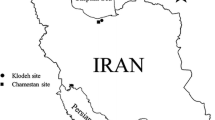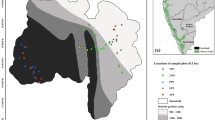Abstract
• Context
A large area of abandoned land in the semiarid temperate region of China has been converted into plantations over the past decades. However, little information is available about the ecosystem C storage in different plantations.
• Aim and methods
Our objective was to estimate the C storage in biomass, litter, and soil of four different plantations (monospecific stands of Larix gmelinii, Pinus tabuliformis, Picea crassifolia, and Populus simonii). Tree component biomass was estimated using allometric equations. The biomasses of understory vegetation and litter were determined by harvesting all the components. C fractions of plant, litter, and soil were measured.
• Results
The ecosystem C storage were as follows: Picea crassifolia (469 t C/ha) > Larix gmelinii (375 t C/ha), Populus simonii (330 t C/ha) > Pinus tabuliformis (281 t C/ha) (P < 0.05), 59.5–91.1 % of which was in the soil. The highest tree and understory C storage were found in the plantation of Pinus tabuliformis (247 t/ha) and Larix gmelinii (1.2 t/ha) respectively. The difference in tree C fraction was significant among tree components (P < 0.05), following the order: leaf > branch > trunk > root. The highest soil C (SC) was stored in Picea crassifolia plantation (411 t C/ha), while Populus simonii plantation had a higher SC sequestration rate than others.
• Conclusion
C storage and distribution varied among different plantation ecosystems. Coniferous forests had a higher live biomass and litter C storage. Broadleaf forests had considerable SC sequestration potential after 40 years establishment.





Similar content being viewed by others
References
Abdallah F, Chaieb M (2012) The influence of trees on nutrients, water, light availability and understorey vegetation in an arid environment. Appl Veg Sci 15:501–512
Cao MK, Woodward FI (1998) Net primary and ecosystem production and carbon stocks of terrestrial ecosystems and their responses to climate change. Glob Chang Biol 4:185–198
Chazdon RL (2008) Beyond deforestation: restoring forests and ecosystem services on degraded lands. Science 320:1458–1460
Chinese Editorial Committee of Soil Analysis (1996) Soil physical and chemical analysis and description of soil profile. China State Standards Press, Beijing, In Chinese
Díaz-Pinés E, Rubio A, Van Miegroet H, Montes F, Benito M (2011) Does tree species composition control soil organic carbon pools in Mediterranean mountain forests? For Ecol Manag 262:1895–1904
Dixon RK, Brown S, Houghton RA, Solomon AM, Trexler MC, Wisniewski J (1994) Carbon pools and flux of global forest ecosystems. Science 263:185–190
Fang JY, Chen AP, Peng CH, Zhao SQ, Ci LJ (2001) Changes in forest biomass carbon storage in China between 1949 and 1998. Science 292:2320–2322
Farley KA, Kelly EF, Hofstede RGM (2004) Soil organic carbon and water retention following conversion of grasslands to pine plantations in the Ecuadoran Andes. Ecosystems 7:729–739
Finzi AC, Van Breemen N, Canham CD (1998) Canopy tree soil interactions within temperate forests: Species effects on soil carbon and nitrogen. Ecol Appl 8:440–446
Guo Z, Fang J, Pan Y, Birdsey R (2010) Inventory-based estimates of forest biomass carbon stocks in China: A comparison of three methods. For Ecol Manag 259:1225–1231
Hobbie SE, Schimel JP, Trumbore SE, Randerson JR (2000) Controls over carbon storage and turnover in high-latitude soils. Glob Chang Biol 6:196–210
Holst T, Mayer H, Schindler D (2004) Microclimate within beech stands-part II: thermal conditions. Eur J For Res 123:13–28
Houghton RA (2005) Aboveground forest biomass and the global carbon balance. Glob Chang Biol 11:945–958
Jandl R, Lindner M, Vesterdal L, Bauwens B, Baritz R, Hagedorn F, Johnson DW, Minkkinen K, Byrne KA (2007) How strongly can forest management influence soil carbon sequestration? Geoderma 137:253–268
Jobbágy EG, Jackson RB (2000) The vertical distribution of soil organic carbon and its relation to climate and vegetation. Ecol Appl 10:423–436
Johnson DW (1992) Effects of forest management on soil carbon storage. Water Air Soil Pollut 64:83–120
Kaul M, Mohren GMJ, Dadhwal VK (2010) Carbon storage and sequestration potential of selected tree species in India. Mitig Adapt Strateg Glob Chang 15:489–510
Laganière J, Angers DA, Paré D (2010) Carbon accumulation in agricultural soils after afforestation: a meta-analysis. Glob Chang Biol 16:439–453
Li KR, Wang SQ, Cao MK (2003) Vegetion and soil carbon storage in China. Sci China Ser D 33:72–80, in Chinese with English abstract
Li X, Yi MJ, Son Y, Park PS, Lee KH, Son YM, Kim RH, Jeong MJ (2011) Biomass and carbon storage in an age-sequence of Korean pine (Pinus koraiensis) plantation forests in central Korea. J Plant Biol 54:33–42
Ma QY (1989) A study on the biomass of chinese pine forests. J Beijing For Univ 11:1–10, in Chinese with English abstract
Martius C, Höfer H, Garcia MVB, Römbke J, Förster B, Hanagarth W (2004) Microclimate in agroforestry systems in central Amazonia: does canopy closure matter to soil organisms? Agrofor Syst 60:291–304
Paul KI, Polglase PJ, Nyakuengama JG, Khanna PK (2002) Change in soil carbon following afforestation. For Ecol Manag 168:241–257
Pérez-Cruzado C, Mansilla-Salinero P, Rodríguez-Soalleiro R, Merino A (2012) Influence of tree species on carbon sequestration in afforested pastures in a humid temperate region. Plant Soil 353:333–353
Schulp CJE, Nabulars GJ, Verburg PH, de Waal RW (2008) Effect of tree species on carbon stocks in forest floor and mineral soil and implications for soil carbon inventories. For Ecol Manag 256:482–490
Silvester WB, Orchard TA (1999) The biology of kauri (Agathis australis) in New Zealand. I. Production, biomass, carbon storage, and litter fall in four forest remnants. N Z J Bot 37:553–571
Sun Y, Wang DX, Zhang H, Li ZG, Wei YF, Hu TH (2009) Forest ecosystem services and their valuation of Ningxia area. J Northwest A&F Univ (Nat Sci Edit) 37:91–97, in Chinese with English abstract
Trum F, Titeux H, Ranger J, Delvaux B (2011) Influence of tree species on carbon and nitrogen transformation patterns in forest floor profiles. Ann For Sci 68:837–847
Vesterdal L, Elberling B, Christiansen JR, Callesen I, Schmidt IK (2012) Soil respiration and rates of soil carbon turnover differ among six common European tree species. For Ecol Manag 264:185–196
von Arx G, Dobbertin M, Rebetez M (2012) Spatio-temporal effects of forest canopy on understory microclimate in a long-term experiment in Switzerland. Agric For Meteorol 166:144–155
Winjum JK, Schroeder PE (1997) Forest plantations of the world: their extent, ecological attributes, and carbon storage. Agric For Meteorol 84:153–167
Zhang QZ, Wang CK, Wang XC, Quan XK (2009) Carbon concentration variability of 10 Chinese temperate tree species. For Ecol Manag 258:722–727
Zhang KR, Dang HS, Tan SD, Wang ZX, Zhang QF (2010) Vegetation community and soil characteristics of abandoned agricultural land and pine plantation in the Qinling Mountains, China. For Ecol Manag 259:2036–2047
Zheng SX, Shangguan ZP (2007) Photosynthetic physiological adaptabilities of Pinus tabuliformi and Robinia pseudoacacia in the Loess Plateau Chinese. J Appl Ecol 18:16–22, in Chinese with English abstract
Funding
Financial support for this research came from the CAS “Strategic Priority Research Program-Climate Change: Carbon Budget and Relevant” (XDA05050202), the State Forestry Bureau Special Fund for Agro-scientific Research in the Public Interest (200904056) and the National Key Laboratory Fund (10502-Z8).
Contribution of the co-authors
Yang Gao: measuring the samples, running data analysis and writing the paper. Jimin Cheng: supervising the work. Zhengrui Ma, Yu Zhao and Jishuai Su: collecting the samples.
Author information
Authors and Affiliations
Corresponding author
Additional information
Handling Editor: Shuqing Zhao
Rights and permissions
About this article
Cite this article
Gao, Y., Cheng, J., Ma, Z. et al. Carbon storage in biomass, litter, and soil of different plantations in a semiarid temperate region of northwest China. Annals of Forest Science 71, 427–435 (2014). https://doi.org/10.1007/s13595-013-0355-z
Received:
Accepted:
Published:
Issue Date:
DOI: https://doi.org/10.1007/s13595-013-0355-z




